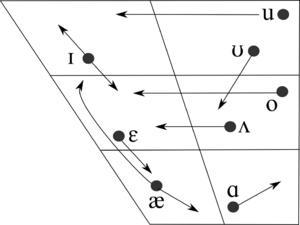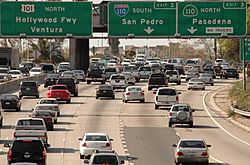California English facts for kids
Quick facts for kids California English |
||||
|---|---|---|---|---|
| Region | United States of America (California) |
|||
| Native speakers | (unknown) | |||
| Language family |
Indo-European
|
|||
| Early forms: |
Old English
|
|||
|
||||
California English is the way people speak English in California. It's a special kind of American English. Linguists, who are language scientists, first noticed a unique way of speaking in California in the 1980s. This was mostly in southern California and the San Francisco Bay Area.
This way of speaking became popular among young, white people living near the coast. It was often linked to the "valley girl" and "surfer dude" styles. Some people think it's just how young people talk. But some parts of this accent are growing stronger and spreading across California.
There are other ways people speak English in California too. These include a "country" accent, an older accent from Irish Americans in San Francisco, and special kinds of Chicano English spoken by Mexican Americans. People in California often notice differences between how people speak in northern and southern California. For example, people in the north often say hella. In the south, people use words like dude, bro, and like a lot. These words have now spread across the country.
California is one of the most diverse states in the U.S. Because of this, English speakers from many backgrounds have shared words and ways of speaking. This has made California English both unique and similar to other accents. Still, most California English sounds like a General or Western American accent.
Contents
Urban Coastal English
The way people speak English in California's big cities along the coast is often what people think of as "California English." One big feature is that the vowel sound in words like caught and stalk sounds the same as the vowel in cot and stock. This is called the cot–caught merger. It's common in most of the Western United States.
Some other sound changes happen in California English. But not everyone in California speaks this way. And sometimes, people outside California might use these sounds too.
- When words have an "ng" sound, like in sing or king, the vowels before it can change. For example, king might sound more like keeng.
- In southern California, words like thinking might sound like theenkeen.
- The "a" sound in words like ran or ram can change to sound a bit different.
- Some people in southern California use uptalk. This is when your voice goes up at the end of a sentence, making it sound like a question.
- Words like egg, beg, and leg can sometimes sound like ayg, bayg, and layg.
California Vowel Shift
One interesting thing about California English is how vowel sounds are changing. This is called a chain shift. Imagine the inside of your mouth where your tongue moves to make sounds. As one vowel sound moves to a new spot, other vowel sounds also shift to make space. This helps keep the sounds clear and different from each other.
Here are some ways vowels are shifting:
- The vowel sound in wreck and kettle can start to sound like the vowel in rack and cattle.
- The vowel sound in cot and stock merges with the vowel in caught and stalk. This means they sound the same.
- The vowel sound in rude and true can move forward in the mouth, almost sounding like reed and tree, but with rounded lips.
- The vowel sound in book and could can start to sound like buck and cud to people from other places.
- The vowel sound in duck and crust can sound like how people in the Southern U.S. say them, or like deck and crest.
These vowel changes are more common among younger speakers in California. Most people don't even notice these changes happening as they speak.
Rural Inland English
In the rural parts of California, away from the big coastal cities, some people speak with a "country" or "twang" accent. This accent sounds a bit like accents from the Southern United States. It's often heard among white people who live outdoorsy lifestyles in the Central Valley.
This accent can be heard from Trinity County in the north down to Kern County in the south. People in towns like Redding and Merced might use the word anymore in a positive way. For example, "It's sunny anymore." They might also use was instead of were for plural subjects, like "They was going."
Other features include:
- The pin–pen merger: pin and pen sound the same.
- The fill–feel merger: fill and feel sound the same.
- The full–fool merger: full and fool sound the same.
This rural accent likely came from the Dust Bowl migrations during the Great Depression. Many settlers moved to California from Southern states like Oklahoma and Arkansas. Even today, whether someone spends more time outdoors or indoors seems to affect their accent more than their family's Southern background. People who live a more "country" lifestyle tend to have more Southern accent features. But they might still show some signs of the California Vowel Shift too.
Mission Brogue (San Francisco)
The Mission brogue was an accent spoken in San Francisco, mostly in the Mission District during the 20th century. It sounded a lot like New York and Boston accents. This is because many Irish Americans moved from those East Coast cities to the Mission District in the late 1800s.
Today, only some of the oldest Irish-American and Jewish residents in San Francisco still speak with this accent. In the past, sounding like a "real San Franciscan" meant sounding "like a New Yorker." People even said they "talk like Brooklynites."
Some features of this accent included:
- Saying "d" instead of "th" in words like this or that.
- The cot–caught merger did not happen. The vowel in caught sounded different from cot.
- Not pronouncing the "r" sound at the end of words, like in car or park.
- Using a stop sound in the throat instead of "t" in words like bottle.
Over time, this unique San Francisco accent has become less common. Younger speakers in the Mission District now sound more like other people in Western America. They have the cot–caught merger and show the vowel shifts common in urban coastal California.
Other Varieties
California also has its own kinds of Chicano English. Sometimes, even non-Latino Californians speak with these accents. One example is East Los Angeles Chicano English. It has been shaped by both Californian and African American Vernacular English.
The coastal urban accent of California got many of its features from Valleyspeak. This was a way of speaking that started in the 1980s among young white people in the San Fernando Valley near Los Angeles.
Boontling is a secret language or jargon spoken in Boonville, California. Today, only about 100 people still speak it.
California Words and Phrases
When people think of a typical southern California speaker, they might imagine "Valley girls" or "surfer-dude" speech. These were made famous by songs and movies in the 1980s. While some of those old phrases are not used much anymore, many words have stayed popular. Words like awesome, totally, for sure, harsh, gnarly, and dude are still common in California. They have even spread across the country and the world.
A common word in northern California is hella. It comes from "a hell of a lot of." It means "many," "much," "so," or "very." You can use it with things you can count, like "There were hella people." You can also use it with things you can't count, like "This guacamole is hella good." The word hecka is a milder version.
California, like other Southwestern states, has borrowed many words from Spanish. This is especially true for place names, food, and cultural items. This shows the history of the Californios and recent immigration from Mexico. Also, because many different ethnic groups live in California, people know words from various cultures. For example, the word hapa is used to describe someone of mixed European/Islander or Asian/Islander heritage. It originally came from Hawaiian.
In 1958, a writer named Clifton Fadiman noted that northern California was one of the few places where chesterfield was used to mean sofa or couch.
Freeways
Top: A sign in Los Angeles for the Hollywood Freeway (U.S. Route 101).
Bottom: A sign in San Francisco for US 101, leading to the Golden Gate Bridge.
In southern California, people often talk about freeways using the word "the" before the number. For example, they might say "the 405 North" or "the 99." This is different from northern California, where people usually just say "405 North" or "99."
When freeways were first built in southern California in the 1940s and 1950s, people called them by their names, like "the Hollywood Freeway." Later, people started using the numbers, but they kept the "the" in front. So, "the Hollywood Freeway" became "the 101 Freeway," and then just "the 101." This way of speaking has even been made fun of on the TV show Saturday Night Live.
See also
 In Spanish: Inglés de California para niños
In Spanish: Inglés de California para niños




